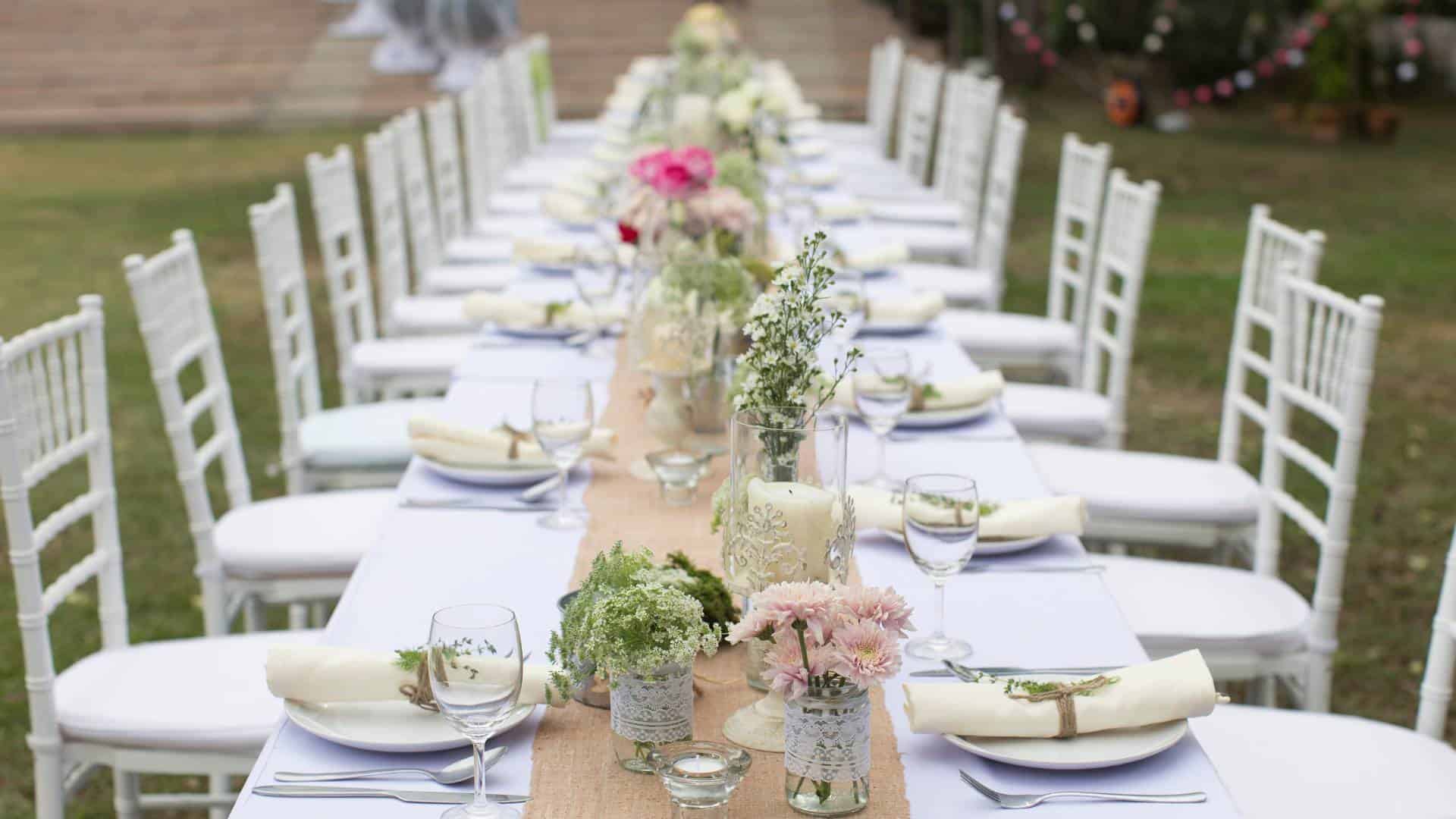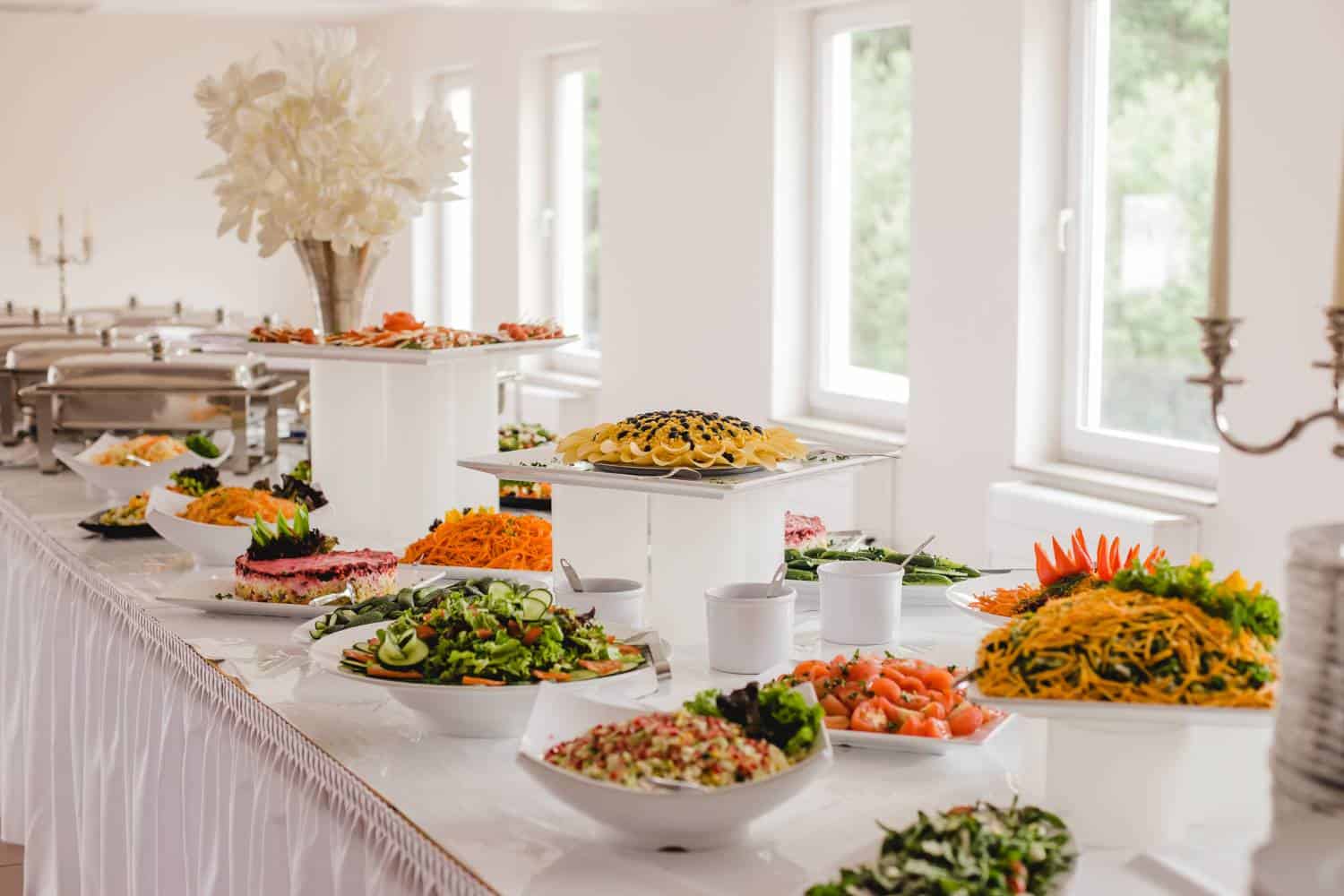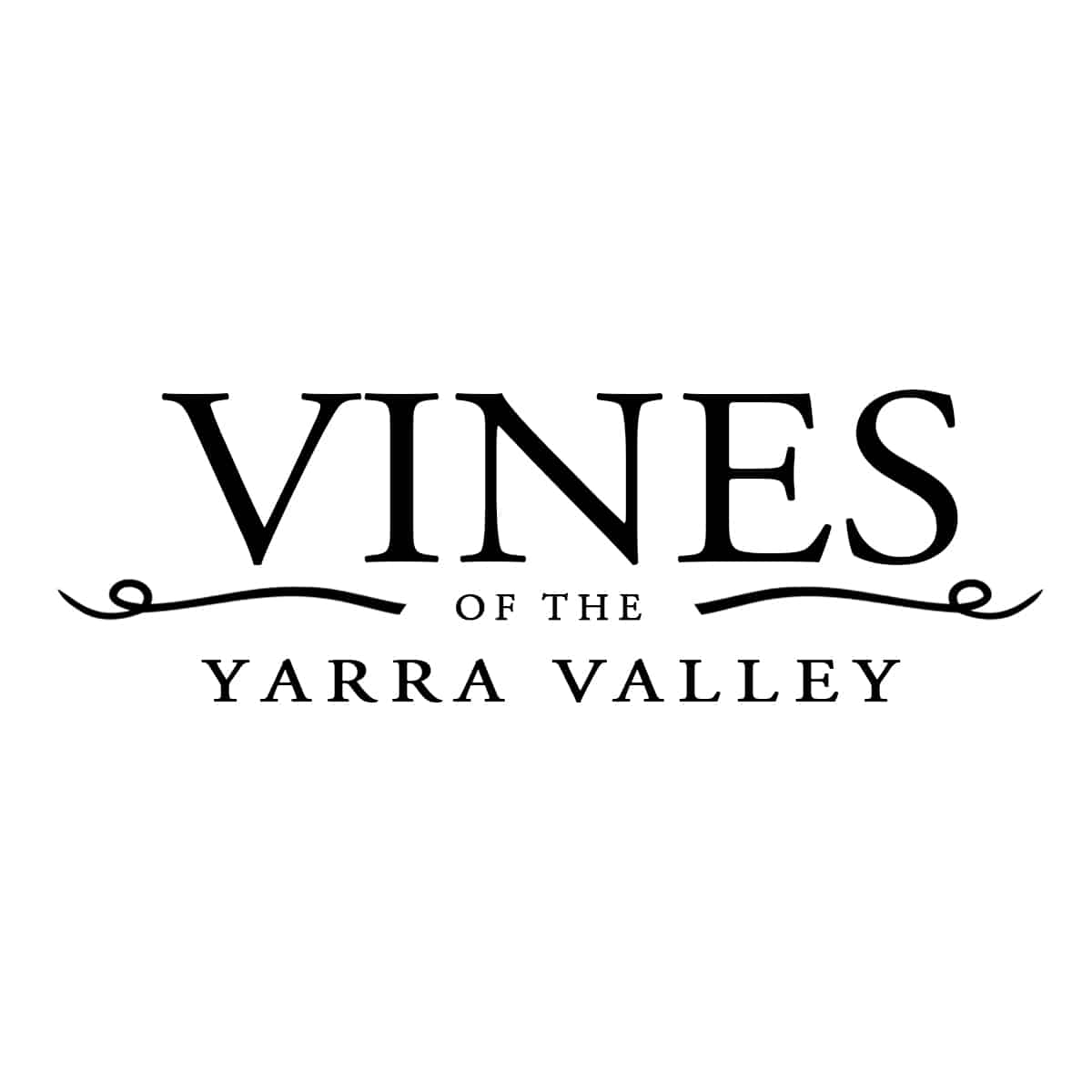Outdoor weddings combine the beauty of nature with the joy of celebration, making them unique and memorable.
However, planning catering for such an event requires special attention to detail, ensuring that everything runs smoothly.
From selecting the perfect venue to managing logistics and planning a seasonal menu, here’s a comprehensive guide to help you navigate outdoor wedding catering.
Let’s get straight to the point
Planning outdoor wedding catering involves selecting the right venue with suitable catering options (in-house, exclusive, or open), ensuring proper kitchen facilities, and having power sources for food warmers and refrigeration.
Tailor the menu to the season and setting, with options like buffets, interactive food stations, or plated meals.
Equip the event with essential gear such as food warmers, outdoor kitchen pods, and tents.
Thoughtfully plan your beverage menu with signature drinks and non-alcoholic options.
Collaborate closely with vendors and have contingency plans for weather. Proper preparation ensures a smooth, memorable outdoor dining experience.
1. Venue and Catering Options
Choosing the right venue is the first crucial step in planning an outdoor wedding. The venue not only sets the atmosphere but also influences your catering options. Consider these catering choices:
- In-House Catering: This option provides convenience, as food is prepared fresh on-site. In-house catering often includes tableware, linens, and staff, saving you the hassle of coordinating with multiple vendors. However, it can limit your ability to customise the menu.
- Exclusive Caterers: Some venues have exclusive caterers who are familiar with the location and logistics. This can lead to more efficient service and a menu tailored to your preferences. However, exclusive catering may restrict your options and increase overall costs.
- Open Catering: If the venue allows, open catering gives you the freedom to choose your own caterer. This flexibility lets you explore creative dining options, from gourmet meals to food trucks. Keep in mind that open catering might require more logistical planning, including hiring additional equipment and staff.
Before finalising the venue, check the available kitchen facilities and power supply for food warmers, refrigerators, and other essential equipment. These considerations will directly impact your menu choices and service style.
2. Tailoring the Menu to the Season and Setting
Creating a menu that suits the season and setting of your outdoor wedding is essential for ensuring that the food is enjoyable and complements the atmosphere.
- Seasonal Ingredients: Choosing seasonal produce ensures the food is fresh and vibrant. For a summer wedding, light dishes like salads and seafood are perfect, while winter weddings may call for heartier meals, such as roasted meats and warm sides.
- Service Style: The way food is served can set the tone for your event. Buffets and family-style dining are ideal for relaxed, informal gatherings, allowing guests to mingle freely. For a more formal occasion, plated meals offer a sophisticated touch.
- Weather Considerations: The weather plays a significant role in outdoor dining. In hot climates, opt for cool, refreshing dishes, while chilly environments are better suited for warm, comforting meals. Ensure that the food presentation matches the weather conditions to maintain quality.
- Interactive Food Stations: Consider including interactive food stations, such as a live barbecue or dessert bar. This adds a fun element to your wedding and allows guests to enjoy freshly prepared dishes on the spot.
3. Essential Equipment for Outdoor Catering
When catering an outdoor wedding, having the right equipment is crucial for maintaining food quality and guest comfort.
- Food Warmers and Chafers: Keeping food at the correct temperature is essential, especially at outdoor events. Ensure your caterer provides food warmers or chafing dishes to maintain the heat of hot dishes without compromising on presentation.
- Outdoor Kitchen Pods: If your venue lacks a kitchen, consider renting an outdoor kitchen pod. These mobile kitchens are fully equipped with ovens, stoves, and preparation areas, allowing the caterers to prepare food on-site.
- Serving Essentials: Plan for all the necessary serving essentials, such as cutlery, glassware, napkins, and tablecloths. These small details contribute to the overall dining experience and should match your wedding theme.
- Tents and Shelters: Protect your guests and food from unexpected weather conditions by setting up tents or marquees. Clear tents offer a modern look, while sailcloth tents provide a more rustic, natural feel. If the weather is unpredictable, this option is a must.
4. Beverage Catering for Outdoor Weddings
Your drink menu is just as important as the food in creating a memorable dining experience.
Whether you’re opting for a casual affair or something more formal, your beverage options should align with the tone of your wedding.
- Signature Cocktails and Mocktails: Personalised drinks are a great way to add a unique touch to your wedding. Signature cocktails or mocktails can reflect your personalities or incorporate seasonal flavours. For instance, a refreshing citrus cocktail in summer or a spiced mocktail in autumn can make a statement.
- Local and Seasonal Beverages: Support local businesses by featuring wines from nearby vineyards or craft beers from local breweries. Using seasonal fruits can also inspire creative and refreshing cocktails that tie in beautifully with your outdoor setting.
- Non-Alcoholic Options: Remember to include a range of non-alcoholic beverages, such as iced teas, lemonades, and artisanal sodas, ensuring all guests have drink options that suit their preferences.
- Coffee and Tea Bars: End the evening on a high note with a coffee or tea bar, offering guests a warm, comforting beverage as the night winds down.
5. Coordinating with Vendors for Outdoor Catering
Successful outdoor wedding catering depends on seamless collaboration between your catering team and other vendors. Clear communication and proper planning are essential.
- Early Communication: Begin discussions with your vendors early to avoid last-minute surprises. Your caterer, florist, and venue coordinator should all be on the same page regarding the event’s schedule and logistics.
- Pre-Event Meetings: Schedule meetings with key vendors to finalise the details, including the event timeline, setup, and food service. These meetings ensure that everyone is aligned and helps prevent any logistical issues on the big day.
- Customising the Menu: Work closely with your caterer to adjust the menu according to guest preferences and dietary restrictions. Be flexible, as last-minute changes to the guest count or menu items may occur.
6. Contingency Planning for Outdoor Weddings
Weather is one of the biggest uncertainties when hosting an outdoor wedding. Proper contingency planning can ensure your event runs smoothly, no matter what nature throws your way.
- Weather Backup Plans: Discuss weather backup plans with your caterer and venue. Ensure that tents, portable heaters, or cooling units are available to keep guests comfortable. In case of rain or extreme heat, having shelters in place will protect both the guests and the food.
- Site Visits: Conduct a site visit with your caterer and key vendors to assess any potential challenges. Look for areas that may need additional power sources or areas prone to wind or sun exposure. Early preparation allows for a smoother event day experience.
7. Post-Event Wrap-Up
After the wedding, a debrief with your vendors is valuable. It allows you to review what worked well and identify any areas for improvement, which can be helpful for future events.
- Post-Event Debriefs: Meet with your vendors after the event to discuss the overall success. This feedback session is not only essential for continuous improvement but also provides a chance to thank your vendors for their efforts.
Conclusion
Catering for an outdoor wedding involves more than just creating a great menu. From choosing a venue with appropriate kitchen facilities to ensuring weather preparedness, every detail matters.
Planning carefully, customising your menu to the season, and working closely with your vendors can create a beautiful and stress-free outdoor wedding dining experience.
With thoughtful preparation and attention to detail, your outdoor wedding will leave a lasting impression on your guests, offering a culinary experience that enhances the joy of your special day.
Frequently Asked Questions
How Do We Choose The Right Menu For An Outdoor Wedding?
Selecting the right menu for an outdoor wedding involves considering the season, the venue’s environment, and your tastes.
Opt for dishes that can be easily served outdoors and remain fresh. Seasonal and local ingredients are fresher and can handle outdoor conditions better.
Discuss with your caterer about creating a menu that reflects the season and offers versatility to accommodate unexpected weather changes.
What Are The Key Food Safety Concerns For Outdoor Catering?
Food safety is paramount in outdoor settings due to varying temperatures and the need to protect food from unwanted pests. Key concerns include:
- Keeping hot foods hot and cold foods cold.
- Ensuring all foods are covered properly.
- Having a plan for quick and safe food disposal.
Your caterer should have experience handling these challenges and be equipped with the necessary tools to maintain food safety, like portable refrigerators and heating apparatus.
How Does Weather Impact Outdoor Wedding Catering?
Weather can significantly impact outdoor wedding catering, affecting everything from food selection to serving style.
High temperatures might require lighter, cooler menu options, while colder weather demands warm, hearty dishes.
Always have a contingency plan with your caterer for unexpected weather changes, such as moving food stations indoors or adjusting the menu at the last minute to suit the weather conditions.
Should We Opt For A Buffet Or Plated Service For Our Outdoor Wedding?
The choice between a buffet and plated service depends on your wedding style, guest count, and available outdoor space.
Buffets offer variety and encourage guests to mingle, but they require careful planning to maintain food temperature and hygiene.
Plated services are more formal and easier to manage outdoors, as the food is prepared and served directly to guests.
Consider your venue’s layout and discuss which option best suits your needs with your caterer and ensures a smooth service.
Can We Incorporate A Themed Or Customised Menu For Our Outdoor Wedding?
Absolutely! An outdoor wedding provides a unique opportunity to get creative with your catering.
Whether you dream of a rustic barbecue, a seaside seafood feast, or a garden party with fresh salads and canapés, your caterer can help you design a themed or customised menu that complements your outdoor setting.
Share your vision and personal favourites with your caterer, and they can tailor the menu to create a dining experience that reflects your theme and delights your guests.



